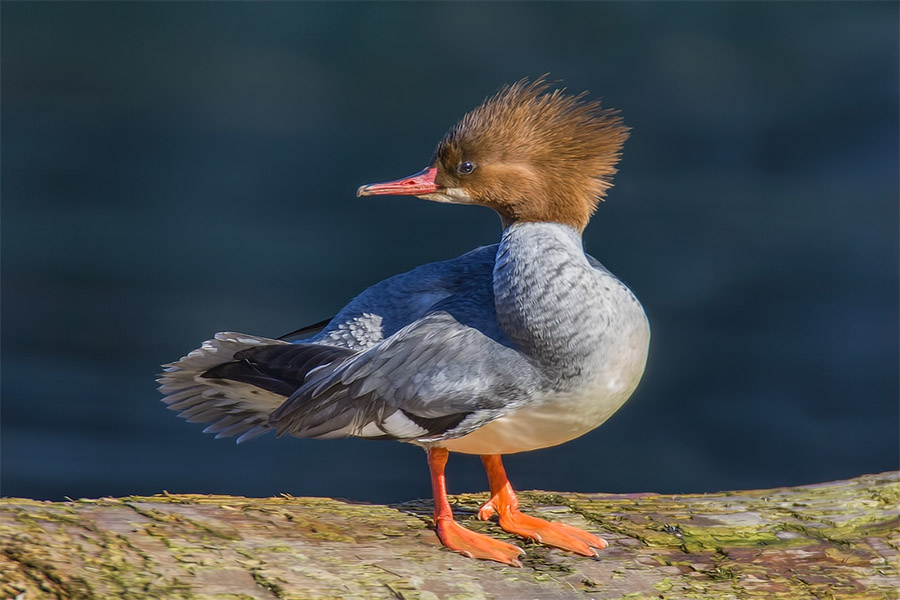Have you seen or heard about the Common Merganser? These birds are well-known because they often float down rivers or along shorelines. Common Mergansers are common in the southwestern, northwestern, northeastern, and central United States.
Common Mergansers have a really interesting name and some fun nicknames. Some of their nicknames are fish ducks, goosanders, and sawbills. The word “merganser” roughly translates to “plunging goose.” It comes from a Latin word, and the translation fits perfectly because these birds are surface divers.
Identification
Common Mergansers are long-bodied large ducks that have pointed, thin wings. Their bills are narrow and straight, making them stand out compared to other ducks. Most ducks have flat, wide bills. Adult male Common Mergansers are distinctly patterned. They have dark green heads and shiny white bodies. Their backs are black, and they have red bills. From late summer to mid-fall, male Common Mergansers have nonbreeding plumage that looks very similar to the plumage of females.
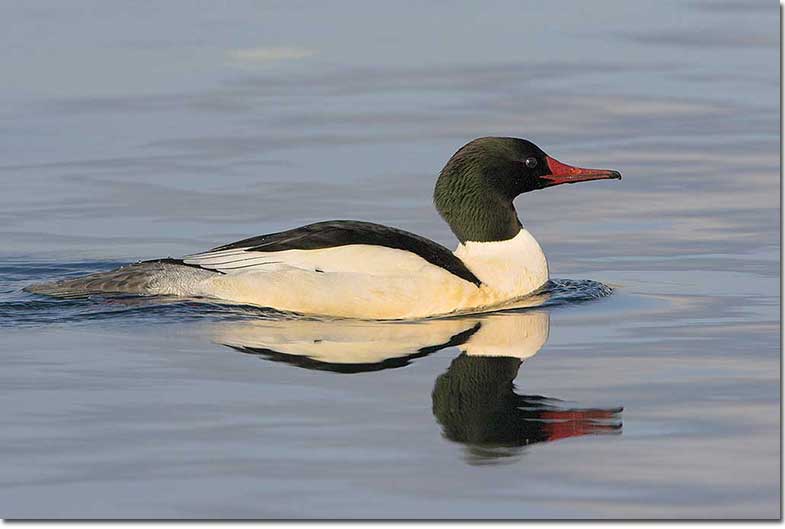
Female Common Mergansers have cinnamon-colored heads, white chests, and gray bodies. They’re the same size as male ducks. They have long bodies, pointed, thin wings, and narrow, straight bills. However, females have one thing that males don’t have, shaggy crests on the backs of their heads. In flight, both males and females have prominent white patches on the upper part of their wings.
Food
Common Mergansers’ diets primarily consist of fish. However, they’re also known to eat worms, insects, crustaceans, mollusks, frogs, plants, and small mammals. These birds can be seen foraging in habitats with clear water, like estuaries, rivers, streams, coastal bays, and lakes. They usually hunt in waters that are around 13 feet deep or less, but in the winter, they’ll sometimes travel into deeper waters because of schooling fish.
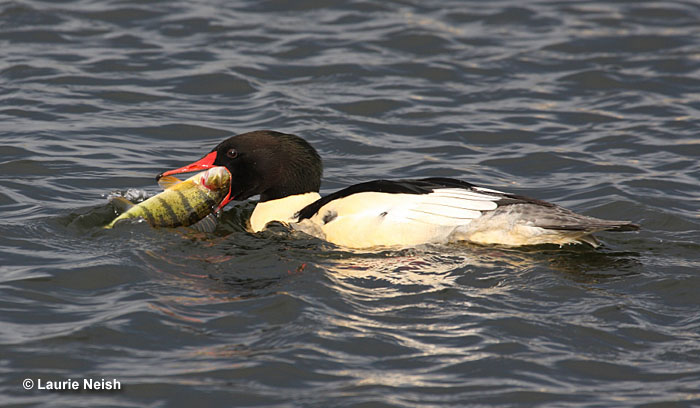
Common Mergansers find their prey with sight and probe underwater stones and sediments with their bills. This works for them because their bills have sharp serrations, which makes it easy to grab slippery prey. They consume primarily fish in the winter months.
Some fish they consume include trout, salmon, suckers, shad, sculpin, sunfish, chub, sticklebacks, eels, and minnows. During the breeding season, they supplement their diet with insects like mayflies, caddisflies, backswimmers, water striders, flies, dragonflies, beetles, crane flies, caterpillars, spiders, freshwater sponges, mussels, and snails.
Nestlings primarily eat aquatic invertebrates and switch to fish when they’re around 12 days old.
Nesting and Eggs
Female Common Mergansers are the ones that choose the nesting site. These ducks prefer to nest in spots within a mile of the water and high off the ground. There’s been recorded nests up to 100 feet off the ground! They usually build their nests in abandoned woodpecker holes and other natural cavities.
However, while this is their preferred location, they’ve also been seen nesting on the ground, in old sheds, rock crevices, lighthouses, chimneys, burrows, and hollow logs. They’ll also happily nest in boxes.
The female Common Merganser is the one to build and shape the nest. She’ll use her body to shape the nest and utilize materials that have accumulated at the bottom of the nesting cavity, like shavings and woodchips. If there’s not enough material, she’ll add some grasses. After laying her eggs, she’ll line the nest with feathers plucked from her chest.
- Clutch size can range from 6 – 17 eggs.
- Egg length ranges from 2.4 to 2.8 inches (6 – 7.2 centimeters).
- Egg width can range from 1.7 to 2.0 inches (4.3 – 5 centimeters).
- Egg color can vary; they can be ivory yellow, white, or even creamy white.
Current Situation
Common Mergansers spend their time in forested habitats near rivers and large lakes during their breeding season. Because these birds prefer to nest in natural cavities in trees, they’re commonly found in mature forests. However, during the winter season, they sped their time on rivers, reservoirs, and large lakes. They usually prefer wintering habitats with freshwater instead of saltwater, but they have been seen wintering in estuaries, harbors, and coastal bays.
They can be seen year-round in most parts of the United states, including Washington, Oregon, Idaho, Montana, Wyoming, Colorado, New York, New Hampshire, Maine, and parts of Canada.
Common Merganser populations have held steady for the last 53 years.
The estimated global breeding population is 1.9 million, and according to the IUCN Red List, they are a species of low concern.
However, this can change due to the increased use of toxic metals and pesticides as well as acid rain.
These issues can degrade Common Mergansers’ habitats, reduce their prey, and thin their eggshells. You would think that because these birds are at the top of the aquatic food chain, they’d be okay. However, this is not the case. Because they’re on the top of the food chain, they become more susceptible to effects like this.
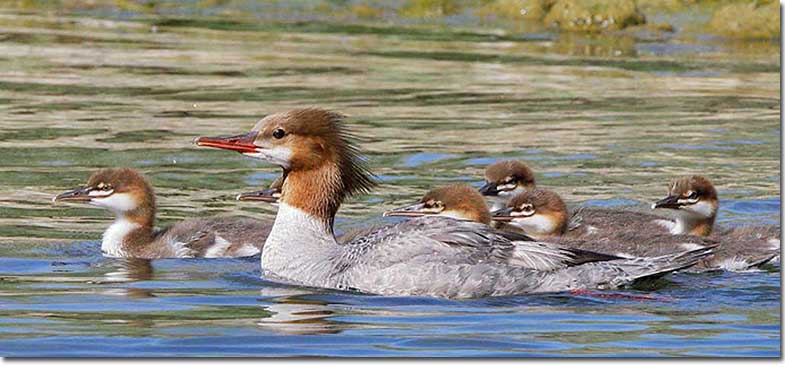
Female Common Merganser
Facts
- Young Common Mergansers leave the nest after a day or so of being born. Unfortunately, their exit is not the most graceful; at this point, young Common Mergansers are flightless, so when they leap from the nest, they tumble to the forest floor. The mother does everything she can to protect her chicks, but they catch all of their food on their own. They start out diving for aquatic insects, but after 12 days, they switch over to fish.
- Common Mergansers are often trailed by other birds. This is because of their position on the food chain. They’re such good hunters that different bird species will follow them, hoping to find food. Gulls are the most common bird species that trial Common Mergansers. They wait for them to come to the surface and try to steal the prey instead of fishing on their own. Bald Eagles have also been seen trying to steal fish from Mergansers.
- Common Mergansers rarely nest in holes in the ground, rock crevices, chimneys, old buildings, and hollow logs. Instead, they prefer to nest in abandoned woodpecker holes and naturally occurring tree cavities. However, sometimes Common Mergansers will take residence in nest boxes as well.
- The oldest recorded Common Merganser was a female. She lived to be at least 13 years and 5 months old. She was initially captured and banded in Oklahoma in 1938. She was then recorded later in Wisconsin in 1950.
Similar Species
The Common Merganser has features that are similar to other bird species. Here are some similar species:
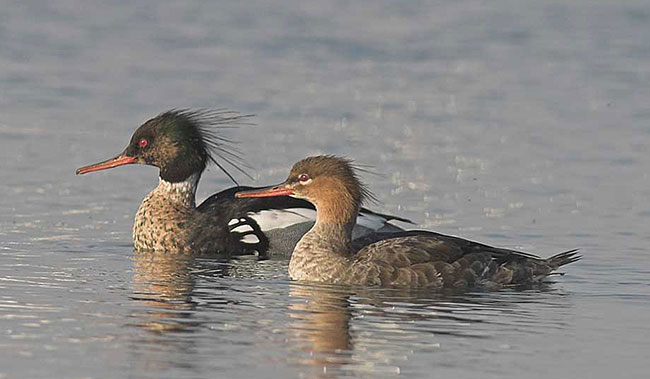
Red-Breasted Mergansers
Red-breasted Merganser – Male Common Mergansers have white breasts, while Red-breasted Mergansers have cinnamon-colored breasts.
Additionally, males have white sides instead of the grayish sides seen on the Red-breasted Merganser.
Nonbreeding males and females have more white on their chests than Red-breasted Mergansers. They also have a white spot below the bill.
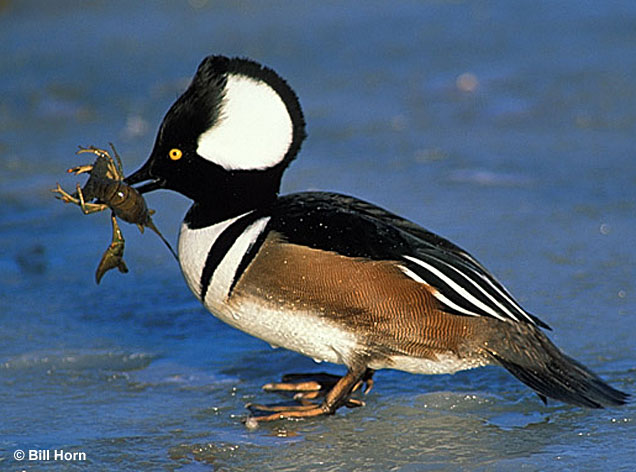
Hooded Merganser
Hooded Merganser – Common Mergansers are bigger than Hooded Mergansers and have larger bills.
The shape of their heads is a bit different too. Hooded Mergansers also have a big white patch on their heads that Common Mergansers do not have.
Female and nonbreeding males are not as brown as Hooded Mergasners as well.
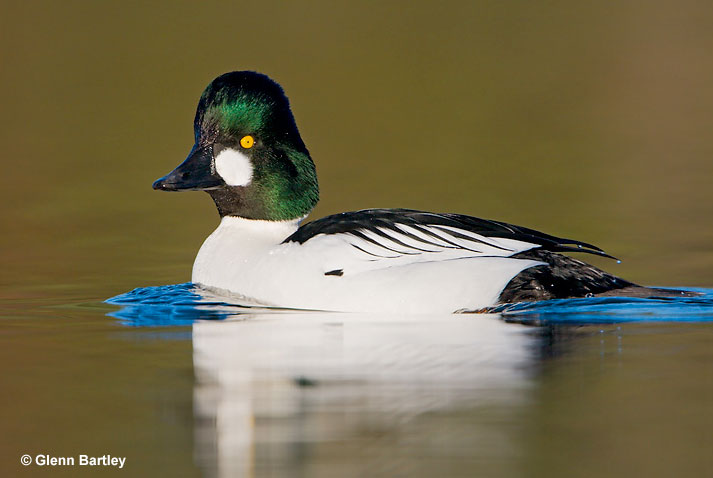
Common Goldeneye
Common Goldeneye – Compared to Common Goldeneyes, Common Mergansers have longer and narrower bills and are larger in size. Additionally, Common Goldeneyes have iridescent plumage on their heads.
Female Common Goldeneyes also don’t have the distinct crest that female Common Mergansers do.
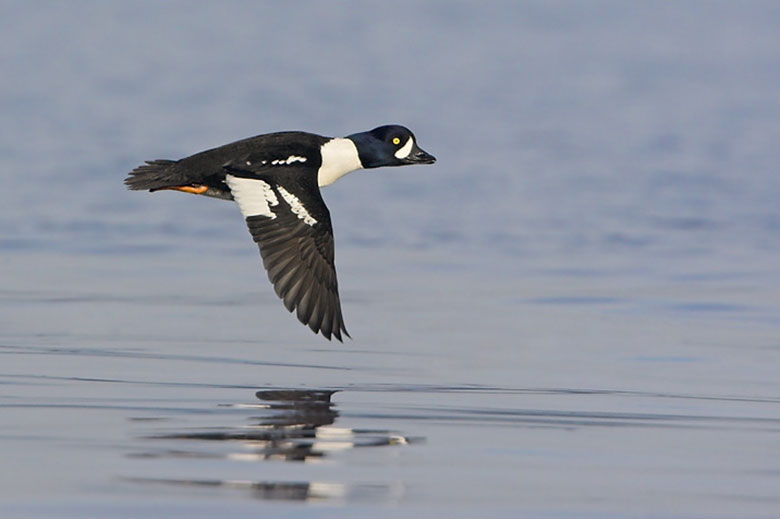
Barrow’s Goldeneye
Barrow’s Goldeneye – Common Mergansers have longer and narrower bills and are larger than Barrow’s Goldeneyes.
Additionally, Common Mergansers have dark eyes, while Barrow’s Goldeneyes have yellow eyes.
FAQ
Is a Common Merganser rare?
Dark-eyed Juncos are not very rare. They’re pretty common. They can be found throughout most of North America and will inhabit spaces close to humans.
Where are Common Mergansers found?
Common Mergansers spend their time in forested habitats near rivers and large lakes. They’re commonly found in mature forests because they prefer to nest in natural cavities.
Where do Common Mergansers go in winter?
During the winter, Common Mergansers spend their time on rivers, reservoirs, and large lakes in New England, midwestern states, southern states, and the Pacific coast of the U.S. and Canada.
What’s the difference between a merganser and a duck?
There isn’t much of a difference. While these birds look different from the “normal” ducks we see more regularly, Common Mergansers are a duck species.
Is a Common Merganser a loon?
No Common Mergasners are not loons. These birds have red bills instead of black bills and iridescent green heads instead of iridescent black heads.
Do mergansers quack?
No, Mergansers don’t quack! Instead, they vocalize and communicate in chatters and grunts.
What does the Common Merganser eat?
Common mergansers mostly eat fish but have been known to eat worms, insects, crustaceans, mollusks, frogs, plants, and small mammals.
How long do mergansers live?
On average, Mergansers live to be around 13 years old.

